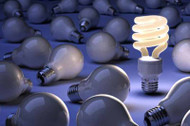The Evolution of LED Lighting Technology
14th Jun 2023
LED light bulbs (Light Emitting Diodes) are not a new technology.
Back in the day, around the late 1960s, when LED light bulbs just began popping up in shops and businesses, bright red was the only color option available for everyone.
These little bulbs were a game-changer for technology at the time, but their use was pretty limited. You'd usually spot them glowing as the turn-on signs for different gadgets like TVs and audio gear. If your TV was on, you’d spot that glowing red light, letting you know that everything was up and running smoothly. This feature was pretty straightforward, but it was super handy in letting folks know if their gadgets were on or off!
Back in the 1970s, a pretty cool advancement happened in the world of technology when engineers and inventors started developing yellow and green LED light bulbs. These little gems weren’t just a flash in the pan; they became quite popular. You often saw them being used as indicator lights on machinery dashboard and controls bringing a new level of safety and quality to manufacturing processes.
Back in the day, LED light bulbs had this fantastic reputation for being super energy-efficient, which is pretty great, right?
But here’s the catch: despite their efficiency, they just weren't popular as a go-to light source.
The problem was that they were often seen as too dim to really light up a room effectively. It wasn’t until a bright spark in technology led to the development of white LED lights that things really started to change in the lighting world. So even though LEDs had this amazing potential, they just weren't cutting it for most folks until that breakthrough came along. They were already showing extended life spans many times that of a traditional light bulb.
These days, when you choose LED light bulbs, you can expect them to last for around 50,000 hours on average. That might sound like just a number at first, but let’s break it down. If you're using these bulbs for about eight hours each day, which is pretty typical for most households, that adds up to over 17 years of continuous use! Imagine not having to think about changing your light bulbs for that long, all while enjoying bright and efficient lighting every day of the year.
So, whether it's for those warm family meals or those late-night book adventures, these bulbs are built to keep glowing all day, every day, without the worry of replacing them often.
In the 1980s, new materials improved the efficiency of LED light bulbs and, more importantly, produced a 10-fold increase in brightness. This enabled the new LED light bulbs to be used more widely in signs, barcode scanners, message displays, and medical applications.
A big change for LED light bulbs happened in 2009. Before that, they were too expensive for most people to buy. Then, a new way to make them came along, and everything changed. The cost of making these bulbs dropped by 90% almost instantly! This meant that this great technology, which used to be too costly, became affordable and attractive for everyone.
Currently there are two main types of LED light bulbs:
- SMD (Surface Mount Diodes)
- High Power (individual) LED light bulbs
Let's talk about LED bulbs, especially the ones that use SMD technology. These bulbs have lots of small LED lights lined up flat on their surface. This smart design gives you a wider light beam compared to regular bulbs.
You might see names like "5050" when looking at SMDs. That’s the newest type, while "3528" is the older one. It’s exciting to see how this tech is getting better!
For example, a regular GU10 LED bulb usually has about 20 of these SMD lights. That’s pretty neat! Even cooler, it gives off as much light as a 50W GU10 halogen bulb, all in a tiny package. Quite amazing, right?
High Power LED (HPLED) light bulbs are getting much brighter as the tech gets better. If we take the GU10 LED bulb as an example, the version with three 2 watt HPLED bulbs gives off light that's about as bright as a 55 watt regular bulb. There's also a similar GU10 LED bulb that uses three 1 watt HPLED bulbs, and it's roughly as bright as a 45 watt traditional bulb.
The original emphasis for LED bulb development was geared to replacing the GU10 and MR16 halogen bulbs because of their high electricity consumption (50 watts).
In 2010, there was a big change in how light bulbs were made. The focus was on creating LED bulbs to replace many old types, like MR11, E14, E27, and bayonet bulbs. They also made LED options for strip lighting. These new LED bulbs are energy-efficient and last a long time. Plus, companies started offering LED versions that could easily replace regular incandescent bulbs, like the common 60W candle and GLS bulbs. This shift was an important step towards better energy use and eco-friendly lighting for all kinds of places.
Things are changing when it comes to lighting, thanks to new laws that aim to phase out incandescent bulbs. These bulbs have been around forever, but they just aren't energy-efficient enough anymore. On the other hand, LED technology has improved a lot. Now, LED bulbs are not just a better option; they're becoming the top choice for most people. Soon, it looks like LED bulbs will be the norm, and those compact fluorescent lamps, or CFLs, which were once seen as a big step up in saving energy, might just be looked back on as a quick stop on the way to better lighting solutions.
LED light bulbs are becoming the go-to option for all your lighting needs, and it's not hard to see why! These bulbs are known to produce a lot more light while using significantly less electricity compared to traditional incandescent bulbs. This means you get brighter, more efficient lighting without the heavy energy bills! Plus, they have an impressively long lifespan, which means you won't have to worry about changing them out as often. And to top it all off, LED bulbs don’t contain any hazardous chemicals that can be harmful to the environment. This makes them not only a smart choice for your wallet but also for the planet, making them the perfect future-friendly lighting solution.
Lately, there has been an exciting breakthrough in the world of LED light bulbs that has really caught the attention of many people interested in energy efficiency. We’re talking about ultra-efficient LEDs, which are pushing the boundaries of how effective these bulbs can be. What’s really impressive is that these new LEDs can reach an efficiency level of over 100 lumens per watt (lm/W), which means they can produce a lot of light while using very little power. This is not just a small improvement; it represents a significant step forward in how we think about and use lighting in our homes and businesses.
In the words of Steve Johnson, who leads a team focused on lighting research at the Lawrence Berkeley National Laboratory, there’s a good chance that the efficacy of solid-state lighting sources could climb even higher. He suggests that, looking ahead to the next few decades, we might see these LEDs achieving incredible efficiencies between 150 to 200 lumens per watt. This could mean even brighter lighting options for us while keeping energy consumption low. One of the key advancements that has made this possible is the use of a semiconductor material called indium gallium nitride (InGaN). This technology has not only allowed for the creation of the brightest LEDs we’ve seen yet, but it has also led to the successful development of white light LEDs, which provide a warm and inviting glow that many people enjoy.
If you're looking to save both energy and money, now's the perfect time to consider making the switch to LED lighting. These innovative light bulbs not only last much longer than traditional options, but they also use significantly less electricity. Imagine being able to enjoy brighter, more efficient lighting in your home while also making a positive impact on your monthly utility bills. So why wait? Start making those smart choices today and explore all the benefits that LED lighting has to offer.

 UK's #1 Specialist LED Retailer
UK's #1 Specialist LED Retailer
 Free Delivery Orders Over £50
Free Delivery Orders Over £50
 28 Day Returns Quality Guarantee
28 Day Returns Quality Guarantee
